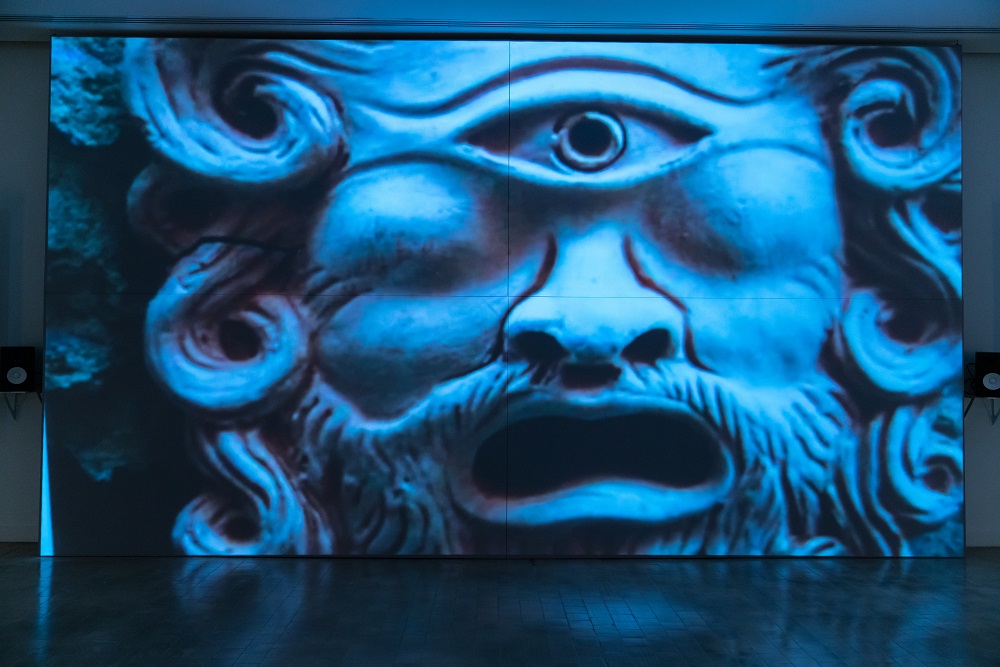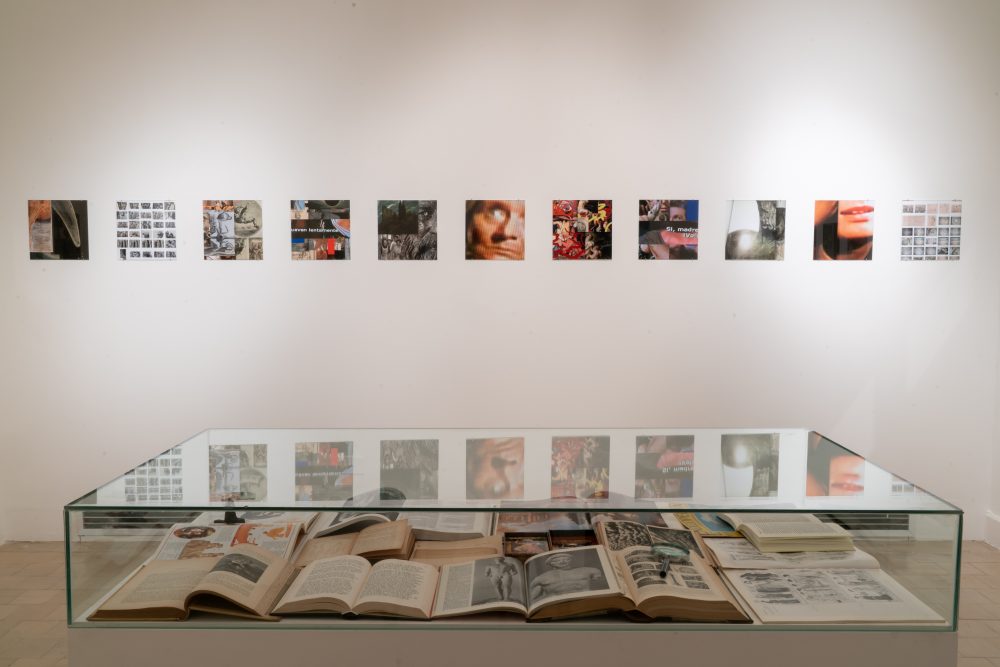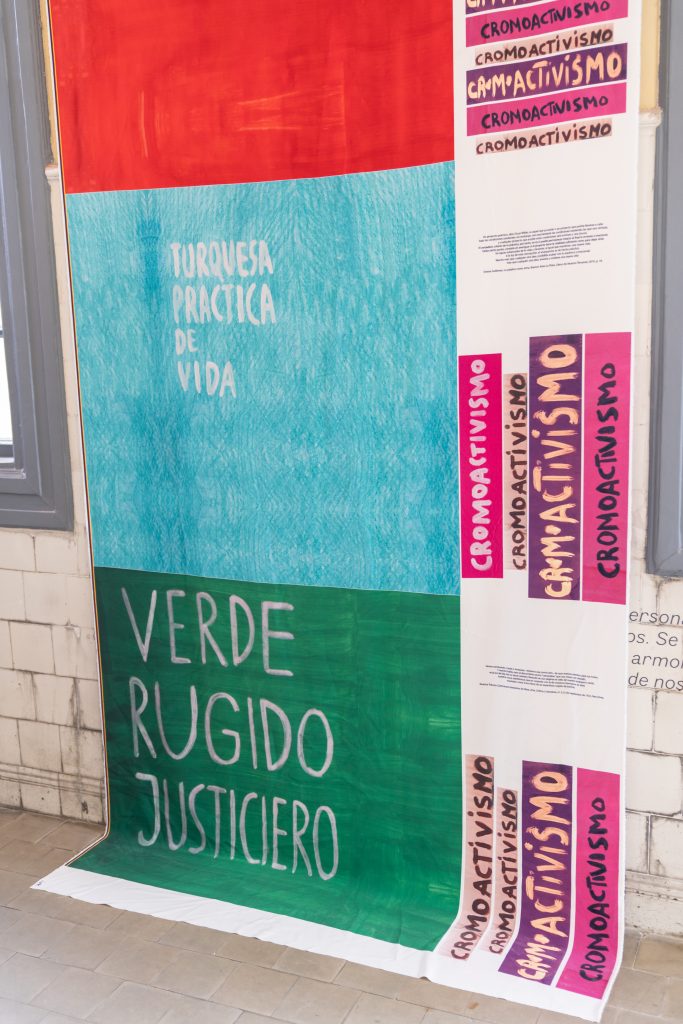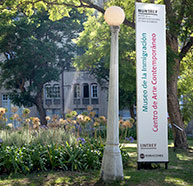Material de descarga
Muestra Stupia
Tabloide Stupia
Tabloide Stupia, English.
Muestra De caro
Tabloide De Caro






Muestra Stupia
Tabloide Stupia
Tabloide Stupia, English.
Muestra De caro
Tabloide De Caro

Ulises Inmigrante. Una fantasía gráfica, de Eduardo Stupía, y Negro que mueve el universo, de Marina De Caro, fueron inauguradas el sábado 8 de septiembre en el viejo Hotel de Inmigrantes, sede del MUNTREF Centro de Arte Contemporáneo. Ambos artistas centran estas muestras en el tema de las migraciones. “Stupía es uno de los artistas más significativos del arte argentino, y Marina De Caro alguien que representa mucho para el arte contemporáneo de nuestro país”, expresó Aníbal Jozami,rector de la Universidad Nacional de Tres de Febrero (UNTREF) ydirector del MUNTREF, quienagradeció a los artistas por las obras realizadas.
Jozamitambién dedicó unas emotivas palabras a uno de los invitados que se acercó a la inauguración:“Quiero agradecer muy especialmente la presencia de quien para nosotros es, quizás, el más grande artista argentino vivo:Yuyo Noé”.
Diana Wechsler, subdirectora del MUNTREF y directora del Departamento de Arte y Cultura de la UNTREF, ahondó en la calidad artística y la elaboración conceptual de las propuestas. “En ambos casos hay una interpretación histórica y contemporánea bien interesante, comprometida con el presente”, aseguró, resaltando que son “dos proyectos fuertemente políticos y pensados desde el lugar de los recursos artísticos”. Además, Wechsler remarcó que no siempre es posible “dar este tipo de debates en proyectos de arte”.
Ulises inmigrante. Una fantasía gráfica es una instalacióninspirada en el periplo del héroe mítico Ulises incluido en el poema griego Odisea, compuesto por Homero. En palabras de Stupía, la obra es unarevisión de ese derrotero a través de textos, imágenes y sonidos que se potencian entre sí.El trabajo plantea una reflexión sobre la subjetividad contemporánea, las migraciones y el exilio.
“Ulises es un inmigrante, no porque lo sea en el sistema político, sino porque en su regreso vuelve a nacer. La idea central es que una vez extraviada la patria no se recupera nunca”, indicó el autor. Otro de los aspectos que gravitan con fuerza en la obra tiene que ver con el conflicto que se produce en el migrante al confrontar su propia lengua con la lengua que lo cobija.
“Este es un trabajo en conjunto y las responsabilidades son compartidas”, explicó el artista, que contó con la colaboración de Daniel Samoilovich en textos y líricas, Pablo Ortiz en música y Julián D’Angiolillo en diseño visual.

Por su parte, Marina De Caro, que expone por primera vez en el MUNTREF, comentó que Negro que mueve el universo“alude a la tradición anarquista de los españoles e italianos que vinieron a nuestro país y tanto nos han marcado”. El trabajo es una intervención en la Sala de Proyectos, en la que se despliegan cerámicas de diferentes colores. El proyecto surgió en el marco de las actividades del colectivo Cromoactivismo, del que De Caro forma parte junto a Guillermina Mongan, Victoria Musotto, Daiana Rose y Mariela Scafati. La artista exploró las identidades cromáticas de las ideologías de muchos de los migrantes que pasaron por el histórico edificio. “El anarquismo también tiene una militancia poética”, concluyó la creadora.

https://jaquealarte.com/eduardo-stupia-y-marina-de-caro-en-muntref/
Biography
Eduardo Stupía is a visual artist born in 1951. He often participates in national and international group exhibitions, prizes and salons.
He has received two of the most important awards in his country: the Grand Prize of the National Salon and the Grand Prize of the Manuel Belgrano Municipal Salon for Drawing.
In the field of visual design, he participated in Gallos y huesos (2012, Centro de Experimentación Teatral – CETC – of the Teatro Colón) and Teatro Martín Fierro (2015, CETC, Teatro Colón), both works with texts by Sergio Chejfec, music by Pablo Ortiz and video production by Julian D´angiolillo; in Maizal del gregoriano (CETC, Teatro Colón – Ciclo Antidiáspora, 2016),with texts by Arnaldo Calveyra, music by Pablo Ortiz and video production by Julian D´Angiolillo; and in El sueño de Úrsula (Centro Cultural Kirchner, 2017), with texts by María Negroni, music by Mariano Vitacco, staging and technical production by Julian D´Angiolillo and direction by Oscar Araiz.
Ulysses credits
IMMIGRANT ULYSSES. A GRAPHIC FANTASY
Video installation. 3 channels
100’
Idea: EDUARDO STUPÍA
Adaptation, texts and lyrics: DANIEL SAMOILOVICH
Original music: PABLO ORTIZ
Visual design: JULIAN D’ANGIOLILLO / EDUARDO STUPIA
Edition: JULIAN D´ANGIOLILLO / DANIELA SEGGIARO
Cameras: JULIAN D´ANGIOLILLO / DANIELA SEGGIARO
Sound mix: PABLO CHIMENTI
Animation: LUCRECIA FRASSETTO
Editing assistants: CONSTANZA CURIA / TANIA D´ANGIOLILLO
Sound technician: NATALIA REMON
Recording studio: TONICA
General coordination: DANIELA SEGGIARO
Paintings: JOSEFINA MADARIAGA, version of Ulysses and Penelope by Francesco Primaticcio and of Circe Offering the Cup to Ulysses by John William Waterhouse. CINTHIA RCHED, version of Ulysses and the Sirens, by John William Waterhouse. JUAN ANDRÉS VIDELA, version of Odysseus and Nausicaa, by Peter Paul Rubens.
Musicians: PATRICIA DA DALT, flute / LUCRECIA JANZA, harp
Singers: AGUSTINA CRESPO / LAUTARO NOLLI
Knitter: ANA FOOS
Readers: EURICLEA: YAELA GOTTLIEB RAMIREZ, ULYSSES: MASSAMBA SEYE / PABLO SAKIHARA / MARIO CÓRDOBA, EURIMACO: JESÚS SERVIGNA JIMÉNEZ, CALYPSO: VAREILA MAIRANGA, ATHENA: MARIA SOL BOLTSIS, TELEMACHUS: KAROL SLAREK, PENELOPE: MELANIE CHONG, ANTINOUS: ARTURS VETSTEINS
Off-screen voice-over: GUILLERMO SAAVEDRA
Institutional Text
The Odyssey is a tale of a long journey and the source of stories that is relocated and goes through various times in this work – a graphic fantasy – by Eduardo Stupía.
With and at the Immigrants’ Hotel, a specific site, he builds this complex collage of moving images, texts and soundtrack, which seeks to create an immersive situation, where spectators embark on their own journey incorporating images, appropriating the montage, activating memories, creating another collage from this extensive original “opera” that results from the endless creativity of Stupía, who undertook the challenge posed by MUNTREF invitation to develop an installation in this space.
Diana B. Wechsler
Short Text
Ulysses’s mythical journey is described in the Greek epic poem The Odyssey, made up of 24 episodes attributed to Greek poet Homer. It narrates the return home of the Greek hero Odysseus – Ulysses in the Latin version -, who, after ten years fighting the Trojan War, embarks upon a long journey back to his lost kingdom on the island of Ithaca, where he held the title of king. The return journey takes another ten years, during which his son Telemachus and his wife Penelope, presuming that Odysseus has died, must confront the suitors who intend to marry Penelope and usurp the throne.
Immigrant Ulysses. A graphic fantasy, is a re-vision of Ulysses’s itinerary in texts, images and sound, on the assumption that through a counterpoint of audio visual and literary formats and the heterogeneous convergence of materials and iconographies, the Odyssey can become a polyhedral trigger of analogies, metaphors and critical resonances concerning such topical issues as contemporary subjectivity, immigration and exile. By means of fictional and documentary cinematographic archive sources, animation, songs and ad hoc music, as well as eccentrics, historical accuracies and anachronisms, calligraphic and pictorial grammars, the turbulent ordeal of the hero is narrated in a kaleidoscopic format, with adapted texts and lyrics by Daniel Samoilovich, music by Pablo Ortiz, and visual technology and staging by Julian D´Angiolillo and Daniela Seggiaro.
Marina de Caro biography
C(r)osmos was published in collaboration with the collective Cromoactivismo, coordinated by Marina De Caro, Guillermina Mongan, Victoria Musotto, Daiana Rose and Mariela Scafati. It complements the exhibition Black: the Moving Force of the Universe (Negro que mueve el universo) by artist Marina De Caro at MUNTREF Centro de Arte Contemporáneo from September 8th 2018.
Marina De Caro is a visual artist born in Mar del Plata in 1961. She holds a degree in Art History from the Universidad de Buenos Aires (UBA). Since 2000 she has directed an art workshop and developed independent projects for the artistic community. She has exhibited in group and solo shows in museums, galleries and international biennials such as the Pontevedra Biennial, Spain (2007); the Lyon Biennial, France (2011); and the 1st Montevideo Biennial, Uruguay (2012). Her work is part of private collections and national and international museums.
Institutional Text
Marina De Caro is the first artist invited to perform an intervention in this hall of the Hotel de Inmigrantes, in this case a site-specific work. Based on the guidelines of Cromoactivismo, a conceptual movement she endorses and is part of, Marina colours and re-signifies this portion of the floor with the shades that provided a chromatic identity to the ideologies of many of the migrants that once stayed here.
It is an invitation to walk into the space, perceive those colours, the ways in which they overlap and gently browse the book where texts and colours expand on the meanings of this installation.
Diana Wechsler
Curatorial Text
The colour of an obstinate dream
In approaching the history of anarchism, the idea is to account for the geopolitical movements of an eccentric idea, an extreme passion, and what Christian Ferrer called “thinking from the outside”. In other words, a kind of antagonistic imagination intent on dismantling any form of political authority, economic subjection and existential domination, which regards the unrestricted principle of freedom as a shared dream, thus radically transforming the hierarchical imaginary pre-established as nature in social history.
Juan Suriano asserts that the convulsive history of libertarian passion cannot be confined to the technicism of labour discipline or the narrow field of trade union demands. Such a history comprises the capacity of small groups with ideological affinities to build a diasporic sensitivity triggered by forced exile which, nurtured by a collective principle of support and care, laid the foundations of a prolific anarchist culture, with its pamphlets, banners, newspapers, reflection circles, affective societies of resistance, schools, libraries and social clubs. The artistic expressions that took place there pedagogically narrated the libertarian principles. This delicate work focused on the design of immediate worlds can be regarded as a form of libertarian sensitivity, in consonance with Martín Albornoz; that is to say, a set of political feelings feeding on tactic elasticity and theoretical flexibility that give rise to the indomitable facets of a libertarian progression, whose singularity lies in the dynamism and heterogeneity used to question the cultures of capitalistic domination.
In this regard, the work by Cromoactivismo, poses a question not only about the historicity of those sensitive modalities of public space occupation, but also about the role of colours in the process of street transformation in the laboratories of poetic experimentation of antagonistic politics. By signalling the protagonism of colorimetry as a technology for social production, Cromoactivismo affords the possibility of its alteration as a possible interphase to interrupt and redesign the collective experience of the living and the sign systems that make up the sensitive machineries that historically define us as social bodies.
On this occasion, their work also represents a historiographic project of critical rewriting, where public experimentation with the history of colour becomes a gateway to a series of critical experiences of political imagination that, victimized by state violence, were decimated by injustice and discouraged by the stigmatization that associated their ideological project with the threatening terror of political uncertainty. The itinerary suggested by this new chromatic palette gathers fragments of a profuse concert of voices that took a harsh stand against the founding agreement of modern imagination by shaping, in turn, the history of a libertarian sensitivity, whose stern echoes can still be heard today.
Nicolás Cuello
Diana Wechsler
